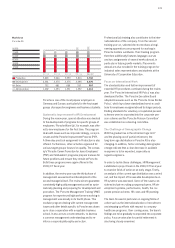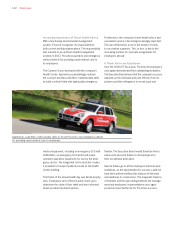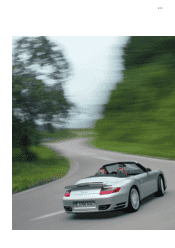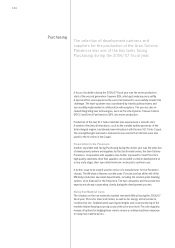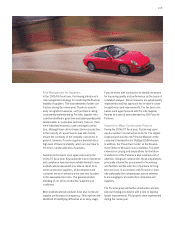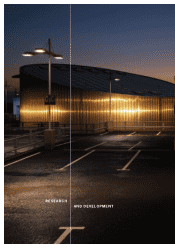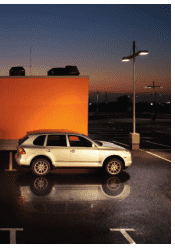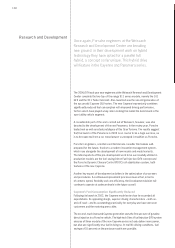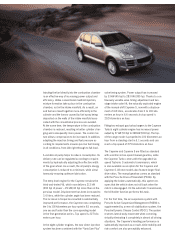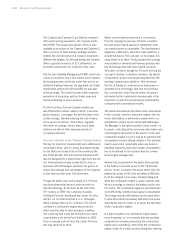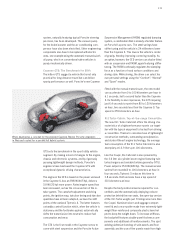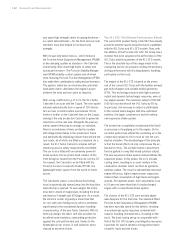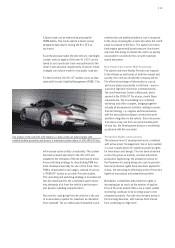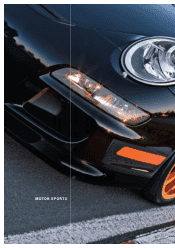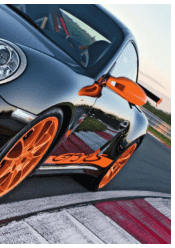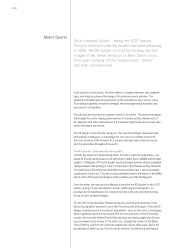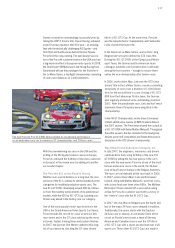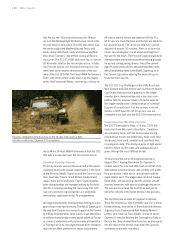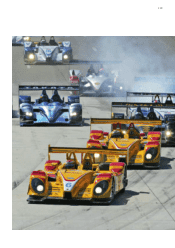Porsche 2006 Annual Report Download - page 113
Download and view the complete annual report
Please find page 113 of the 2006 Porsche annual report below. You can navigate through the pages in the report by either clicking on the pages listed below, or by using the keyword search tool below to find specific information within the annual report.
111
system, naturally featuring typical Porsche steering
precision, has been developed. The vacuum pump
for the brake booster and the air conditioning com-
pressor have also been electrified. Other engineering
components also have to be replaced with electric
ones, one example being the automatic transmission’s
oil pump, which on conventional sales vehicles is
purely mechanically driven.
Cayenne GTS: The Benchmark for SUVs
The letters GTS suggest a vehicle that is not only
practical for long distance travel but can deliver
sporty performance as well. Porsche’s new Cayenne
GTS sets the benchmark in the sport utility vehicle
segment. By making a host of changes to the engine,
chassis and electronic systems, and by rigorously
pursuing lightweight design methods, Porsche’s
engineers have bestowed the Cayenne GTS with
exceptional dynamic driving characteristics.
The engine in the GTS is based on the power unit used
in the Cayenne S, but, at 298 kW (405 hp), delivers
15 kW (20 hp) more power. Rated engine speed has
been increased, as has the cross-section of the in-
take system. The camshaft adjustment switching
points, the ignition map, injection timing and injection
quantities have all been adapted, as have the shift
points of the optional Tiptronic S. The latter features
a standby control function which, when the vehicle is
stationary and the footbrake applied, automatically
shifts the transmission into neutral to reduce fuel
consumption and wear.
The GTS is the first model in the Cayenne series to
come with steel suspension and the Porsche Active
Suspension Management (PASM) regulated damping
system, a combination that is already a familiar feature
on Porsche’s sports cars. The steel springs have
stiffer tuning and the vehicle is 24 millimeters lower
than the Cayenne S. This lowers the vehicle’s center
of gravity, thereby improving cornering stability. As
an option, however, the GTS version can also be fitted
with air suspension and PASM, again featuring stiffer
tuning. The PASM continually regulates the damping
force as a function of road surface conditions and
driving style. While driving, the driver can select his
own personal settings using the “Comfort”, “Normal”
and “Sport” modes.
Fitted with the manual transmission, the new model
can accelerate from 0 to 100 kilometers per hour in
6.1 seconds, half a second faster than the Cayenne
S. Its flexibility is also impressive, the GTS requiring
just 6.4 seconds to sprint from 80 to 120 kilometers
an hour, two seconds less than the Cayenne S. Top
speed is 255 kilometers an hour.
911 Turbo Cabrio: Top-of-the-range Convertible
The new 911 Turbo Cabriolet offers the driving cha-
racteristics of a high-performance sports car toget-
her with the typical enjoyment to be had from driving
a convertible. Thanks to consistent use of lightweight
construction methods, outstanding aerodynamics
and state-of-the-art engine technology, the average
fuel consumption of the 911 Turbo Cabriolet is also
exemplary at 12.9 liters per 100 kilometers.
Like the Coupé, the Cabriolet is also powered by
the 3.6 liter six-cylinder boxer engine featuring twin
turbochargers and variable turbine geometry (VTG).
Power output is 353 kW (480 hp). The manual version
sprints from standstill to 100 kilometers an hour in
four seconds; Tiptronic S reduces this time to
3.8 seconds. Both versions have a top speed of
310 kilometers an hour.
Despite the body reinforcements required for con-
vertibles and the automatically deploying rollover
protection behind the rear seats, the open-top version
of the 911Turbo weighs just 70 kilograms more than
the Coupé. Aluminum doors and luggage compart-
ment lid and a rear spoiler made from extremely light-
weight fiber-reinforced composite plastic have hel-
ped to keep the weight down. To increase stiffness,
the bodyshell features double-panel thickness com-
ponents and additional sill reinforcements. The spot
welding/adhesive bonding of side panels and floor
assembly and the use of fine panels made from high
When developing a concept for the planned Cayenne Hybrid, Porsche engineers
in Weissach opted for a parallel full hybrid system.


